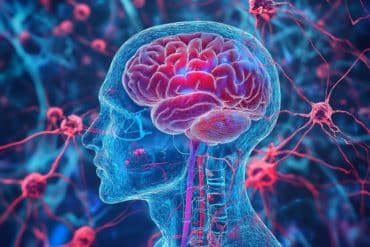Summary: Physical stress responses such as nail-biting or fidgeting may have evolved to show we are in a weakened state, prompting others to act more positively toward us.
Source: University of Portsmouth
Showing signs of stress could make us more likable and prompt others to act more positively towards us, according to a new study by scientists at Nottingham Trent University and the University of Portsmouth.
Researchers examined the paradox of stress behavior, namely why, as in other primates, humans show signs of stress—such as scratching, nail-biting, fidgeting, and touching their face or hair—which could demonstrate to others that they are in weakened state.
They found that, as well as being able to accurately identify when someone was stressed, people reacted more positively towards to the individuals who showed more signs of stress.
As part of the study, participants were videoed while taking part in a mock presentation and interview which they had to prepare with very short notice. The videos were presented to raters, who were asked to rate how stressed they thought the person in the video was.
The participants who reported feeling more stressed during the task were perceived as being more stressed by the raters. Similarly, those showing more self-directed behaviors during the task, such as scratching and nail-biting, were also perceived as more stressed.
The findings suggest that people can accurately detect when others are experiencing stress from their behaviors—something which surprisingly has yet to be shown with scientific evidence.
The participants who were identified as being more stressed during the task, were also perceived as more likable by others, giving a clue as to why humans have evolved to display stress signals.
Dr. Jamie Whitehouse, research fellow at NTU’s School of Social Sciences and research lead, said: “We wanted to find out what advantages there might be in signaling stress to others, to help explain why stress behaviors have evolved in humans.
“If producing these behaviors leads to positive social interactions from others who want to help, rather than negative social interactions from those who want to compete with you, then these behaviors are likely to be selected in the evolutionary process. We are a highly cooperative species compared to many other animals, and this could be why behaviors which communicate weakness were able to evolve.”

Co-author Professor Bridget Waller added: “If the individuals are inducing an empathetic-like response in the raters, they may appear more likable because of this, or it could be that an honest signal of weakness may represent an example of benign intent and/or a willingness to engage in a cooperative rather than competitive interaction, something which could be a ‘likable’ or preferred trait in a social partner.
“This fits with current understanding of expressivity, which tends to suggest that people who are more ’emotionally expressive’ are more well-liked by others and have more positive social interactions.”
Discussing the next steps, co-author Dr. Sophie Milward from the University of Portsmouth added: “Our team is currently investigating whether young children also show this sensitivity to stress states. By looking at childhood we can understand how difficult it is to detect stress, as well as identifying how exposure to adults’ stress might impact young children.”
About this stress and evolutionary neuroscience research news
Author: Press Office
Source: University of Portsmouth
Contact: Press Office – University of Portsmouth
Image: The image is in the public domain
Original Research: Open access.
“Signal value of stress behaviour” by Jamie Whitehouse et al. Evolution and Human Behavior
Abstract
Signal value of stress behaviour
Physiological and psychological stress are accompanied by nonverbal behaviour across a wide range of species. The function of this ‘stress behaviour’ is not well understood but is often assumed to be read by others as a cue to stress. Displaying signs of weakness is, however, difficult to understand from an evolutionary perspective and therefore further investigation into why these behaviours exist is needed.
Here, we test whether displacement behaviours (i.e., those known to be associated with stress) are reliable indicators of stress in humans.
To do this, we presented raters (N = 133) with videos of individuals (N = 31) undergoing a stress-inducting task. Self-directed displacement behaviours and self-reported stress were both associated with stress ratings given by raters. Therefore, such behaviours can provide reliable information to others and can be considered communicative.
Individuals producing more nonverbal stress behaviour were rated as more likeable by raters (perhaps presenting as more honest signallers), indicating a benefit and potential adaptive function of displaying stress. Raters also differed in their accuracy in detecting stress from nonverbal cues.
Findings suggest that the accuracy with which individuals were able to detect stress was linked to the number of social connections they reported to have. However, this association was non-linear, with individuals who were most and least accurate reporting the least network connections.
This could indicate that the ability to read behaviour is associated with an ability to form and maintain social networks.






